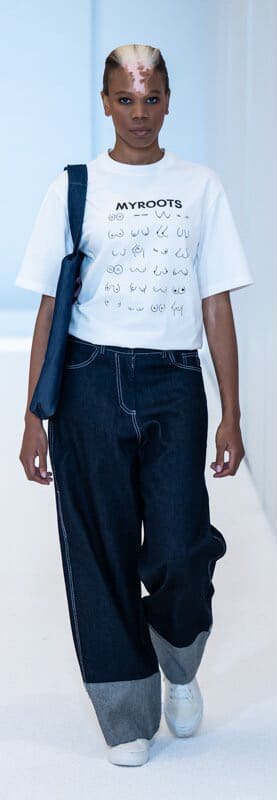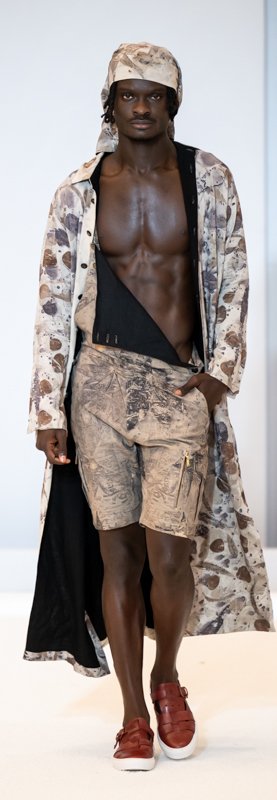SA Fashion Week 2025 Highlights – Behind the Designers
- Lesley Moyo

- May 5
- 5 min read
Updated: May 13
South African Fashion Week 2025 was more than a celebration of style—it was a convergence of ancestral knowledge, experimental expression, and emotional storytelling. With each designer revealing a deeply personal and cultural truth through fabric and form, the runway became a vessel for resistance, restoration, and radical imagination. This year, fashion was not just worn—it was embodied.
Oddity – A Whimsical Homage to Heritage

Oddity’s collection bloomed from childhood memories, particularly her grandmother’s garden—a place of peace, scent, and sensory comfort. These intimate reflections materialized as botanical prints, knit textures, and silhouettes that mimicked organic growth. Each look whispered stories of rootedness and soft rebellion.
“I remember spending hours with my gran in her garden. The textures, the colours, the smells—they shaped how I see beauty,” Oddity shared.“This collection is my way of capturing that warmth and bringing it into a world that often feels too fast and disconnected.”

Operating independently despite local production challenges, Oddity emphasized emotional resonance over mass appeal.
“I’m not trying to fit into trends. I’m trying to make people feel something. That’s how our stories survive.”
SIXX6 – Spirit, Texture, and Sacred Smoke

Titled Impepho, SIXX6’s collection was a visual incantation. Drawing from Xhosa spiritual practices involving the sacred herb impepho, the collection embodied smoke, memory, and unseen presence. Draped forms and minimal palettes conveyed ritual and vulnerability, while textures echoed ancestral grounding.
“Impepho is more than a plant—it’s how we speak to our ancestors. I wanted the garments to carry that energy,” SIXX6 explained.“It’s about reverence, but also about the softness men aren’t usually allowed to show.”

Driven by what he calls “sensory intelligence,” SIXX6 invites wearers into spiritual and emotional dialogue.
“Every design is a prayer, a conversation between body and spirit.”
MYROOTS by Boitumelo Masehla.
Mapula Collection – Dressing Memory, Honoring Lineage

Boitumelo’s MYROOTS offered a deeply reverent homage to familial heritage. Her reinterpretation of the jikisa—a traditional Tswana and Sotho garment—infused cultural pride with modern denim and symbolic embroidery. Every stitch honored her late grandmother, a dressmaker whose legacy lives through each thread.
“My grandmother never saw herself on runways or billboards, but she was the most stylish woman I knew,” Mapula said.“This collection is a thank-you. It’s about giving her story the visibility it always deserved.”

For Boitumelo, MYROOTS is more than a brand—it’s a cultural archive.

“We’re preserving our dress codes, our language, our spirit. It’s fashion as remembrance.”
James Presents – Tailoring Soweto’s Soul

James Presents merged sharp tailoring with the spirit of Soweto’s golden era. Inspired by street portraits of locals in Sunday best, his collection balanced minimalism with coded symbolism. Triangles, circles, and subtle detailing reflected heritage, masculinity, and introspection.
“There’s a dignity in how our uncles and fathers dressed back in the day. They didn’t have much, but they carried themselves,” James reflected.“I wanted to bring that back—structure with meaning.”
Though commercially savvy, James remains grounded.
“My dream is to build globally, but I’ll never detach from Soweto. That’s the soul of everything I do.”

Ecstatic – Conceptual Emotion and Radical Vulnerability

For Ecstatic, fashion is therapy, rebellion, and art. This season’s collection, stitched together amid load-shedding and personal upheaval, channeled Renaissance silhouettes, deconstruction, and raw asymmetry. Performance art and healing processes inspired the garments’ movement and form.
“There were days I was crying at the sewing machine, just trying to get the power back on,” Ecstatic confessed.“But that struggle made the work even more honest.”
Every piece felt like a wearable diary, blending intimacy with theatricality.
“I want people to feel seen, to know it’s okay to be messy, soft, and loud all at once. That’s what Ecstatic is about.”

Naked Ape by Shaldon Kopman – Ritual, Rust, and Stillness

Shaldon Kopman closed fashion week with quiet power. Naked Ape’s Urban Camo was a meditation on urban life and natural rhythm, created with botanical artist Ira Bekker. Rust, leaves, and soil were used to dye fabrics, turning decay into design.
“The city never sleeps, but nature teaches you to pause,” Kopman said.“This collection is my response to burnout—to the need to be still and let things age.”
Structured tailoring met earthy textures, creating garments that felt like relics from the future.

“Time leaves marks. Instead of hiding them, we let them guide the design.”

E_mania – Tribal Markings, Digital Rebellion, and Cultural Sustainability

A visual disruptor on the runway, e_mania’s collection Wear Your Markings reimagined African tribal body art through bold digital prints. Inspired by traditional scarification and cultural identifiers worn by African women, the collection became a modern-day call to reclaim and wear one’s history with pride.

“Our latest collection draws inspiration from African tribal body markings—symbols that have long represented identity, social status, and heritage,” they explained.“We reimagined these marks through bold digital prints… using modern graphic design as a bridge between tradition and the contemporary.”
Their aesthetic—equal parts streetwear and fine art—was intentionally disruptive.
“Our work exists at the intersection of rebellion and reclamation. Identity is a constant thread, while futurism helps us imagine new worlds,” they shared.“We’re not afraid to disrupt, because disruption opens space for authenticity.”
And the message?
“The story we tell through our graphics helps us conserve our heritage and culture, that’s the truest form of sustainability for us.”
Looking ahead, e_mania is focused on expansion.

“We will be showcasing again in September and we are currently working on getting our garments into stores to expand our footprint.
Tadi Wa Nashe - Reclaiming Narrative Through Fabric

Tadiwanashe’s designs don’t just speak to aesthetics, they reclaim space and narrative. Her latest collection confronts the historical silencing of women's complexity by boldly celebrating multiplicity. Each look speaks to a version of womanhood that refuses to be boxed in. There is an intentional contrast between fluid drapery and structured tailoring, as if to say, strength and softness coexist. This duality, paired with references to ancestral femininity and biblical archetypes like Deborah, reflects a deep inner dialogue, stitched into each seam.
Spirituality as Style Compass
Faith plays a central role in Tadiwanashe’s process, not only in theme but as a guiding force in her creative decisions. “My faith is my compass,” she says, a statement that resonates throughout the visual narrative of her garments. Whether it’s in the subtle use of red to symbolize spiritual warfare or the ceremonial shapes found in layered silhouettes, there’s a reverence in the work, a sense that each garment is part of a divine blueprint. For Tadi Wa Nashe, fashion is more than statement, it is stewardship.

Towards the Future of African Couture
With this collection, Tadi Wa Nashe asserts her vision for a future where African fashion is not just consumed for its trends but understood for its philosophies. Her work challenges viewers to look beyond surface beauty and witness the layered symbolism, hats that nod to womanhood’s many roles, textures that echo lived experience, silhouettes that invite transformation. As she carves her path forward, one thing is clear: this is not just about clothing. It is a manifesto for multidimensionality and she’s only just begun.

SA Fashion Week 2025 was a manifesto. It affirmed that African fashion is not monolithic but mystical, modern, and multilayered. From spiritual ritual to digital rebellion, each designer left a mark not just on the runway, but on the collective consciousness of what fashion can be.
As the global fashion world looks for meaning in a post-trend landscape, South African designers are already there, leading with history, emotion, and fearless imagination.






























































Comments